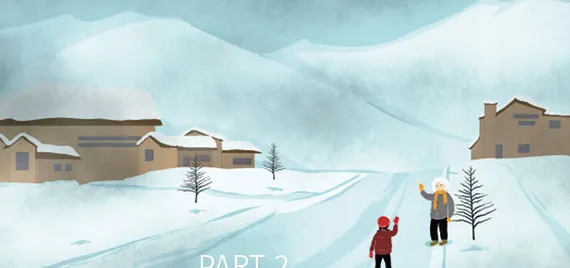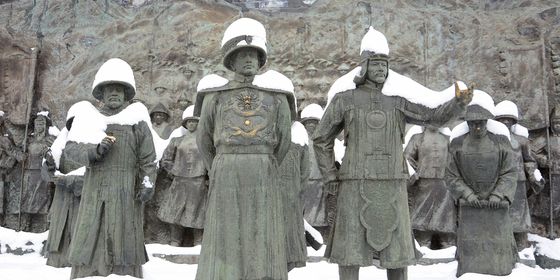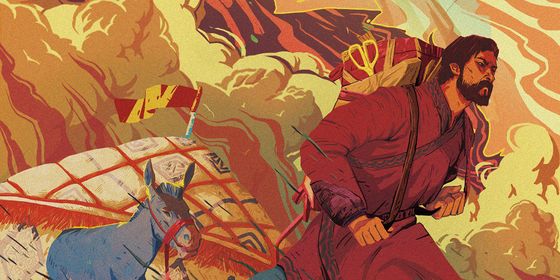Winter is always quiet and it will always happen again
Missed Part 1? You can find it here.
She had moved to the town in the last couple of years. My grandfather died and there was no reason to leave her in the village, alone in that house. It had white walls and a black tiled roof with a narrow gutter outside the door. A mujin rose shrub filled with purplish white flowers grew beside the ditch, but back then I only knew to call them “mitanghua” after the color of the rice gruel they resembled. When my grandmother cooked noodles she picked two of them and added them to the pot. She then added dark green pea shoots and I would get a bowl of colored noodles.
A few steps from the yard there was a river bank where we washed clothes. I remember picking up the wooden mallet, beating it on slate stones and scooping up a small lump of soap to watch it melt in the water. The sunlight always made a rainbow in the suds. A bamboo forest grew along the banks and in the spring after the washing, we dug bamboo shoots. It was easy enough to fill one basket. The shoots were either stir-fried with meat or pickled in an earthen jar for the afternoon. We ate them straight. They weren’t too salty. I sat in the yard, watching my grandmother stitch soles, getting up from time to time to fish a shoot out of the jar. She grumbled that there would be nothing left for breakfast, but she never stopped me.
Sometimes the roof leaked and my grandfather would set up the ladder. His feet thumped on the tiles while she stood in the yard below feeding the chickens. She kept an eye on him right until he stepped off the last rung. They never raised more than four chickens at a time, but everyday a few warm eggs were pulled from some mysterious place. Sometimes they came plastered with chicken poo that was just as warm as the eggs and gave off a smell that I found homely. The previous year they had slaughtered a chicken to stew and its stomach was filled with strings of little eggs. A few of them had already grown half-shells, but were still a little soft. Most of them were the size of grapes and hanging on the lining of the belly. One mouthful held many. In Dream of the Red Chamber there’s a saying that only the elderly can eat the things that haven’t seen daylight. But those eggs were always divided among the children. I liked eating the smallest string.
Inside their house my grandparents burned honeycomb briquettes, but in the yard there was a stove they had installed themselves. When they hosted guests they used it with the big wok for a stir-fry or to cook rice. In the winter it was used to smoke meat and sausages. Bamboo leaves from outside were burned for fuel. Dustpan-full after dustpan-full were swept into the yard and piled into a corner. It gave me an odd sense of abundance. A huge cattail-leaf fan was used to grow the fire. Thick smoke coursed upwards, forming different images before floating to some faraway place. There was also a millstone in the yard. When the soybeans were ripe, my grandmother made her own soft tofu. At first she worked the stone herself and later her sons in law did it for her. The water that the beans were boiled in turned into a bitter milk and we all had to drink bowls of the stuff. When she moved to the city she wanted to bring the millstone with her, but everyone lived in tiny houses. Nobody had space for it and she was forced to leave it behind. If we wanted to eat soft tofu we took an empty bowl out to the street. It was one kuai a serving and the chili bean sauce came in a plastic bag. The street vendors were businesspeople willing to make the extra effort, so the sauce was filled with chopped peanuts, roasted sesame seeds and fermented beans cut
into the finest slivers. We all said this tofu was much better than the kind we made ourselves.
She first lived with my uncle in the city. He was her only son and beneath him was her only grandson. But they both had wives. The five of them were squeezed into a 60-square-meter apartment on the fifth floor. There were no lights in the stairwell. She had to feel along the wall to get downstairs. She rarely went out and spent most of her time on the sofa watching TV. She couldn’t read and couldn’t really understand standard Chinese. She was only able to look at the pictures or listen to the sounds—pop-pop sounds. At her house in the country there had been a black and white television, but the antenna was broken, filling the pictures with snow. But that house was spacious and received plenty of light. It took a long time to walk from the yard to the innermost room. There, the table pushed against the windowsill was covered with bottles and jars. I often snuck in to open an earth-yellow jar, dug out a lump of laozao and shoved it in my mouth. It was fermented sticky rice that hadn’t been diluted with water yet. It was strong and that five or eight year old version of me would get a little tipsy.
From my uncle’s, my grandmother then moved to my second aunt’s in a suburb. The house was big and they were so worried about it getting demolished that they couldn’t decide whether or not to renovate it. The frame around the door was earth-yellow and the toilet was a pitch black hole. When it was time to flush they had to ladle the water out of a bucket. That was still much better than her previous house. There the public toilet had been a 10-minute walk up a slope and the stench of pee always hit after five, so we never got lost.
My aunt was good to my grandmother. Every day she took her for a walk around the town. Now that was a quiet place. There was only one pharmacy, one hardware store, and two or three grocers. There were two butchers where half pigs hung on steel hooks. Customers only needed to point to the section they wanted to buy and the butcher sliced it off for them. The cuts with skin and fat sold the fastest. Everyone loved making huiguorou. The fatty meat was first boiled then stir-fried with onions, fermented beans, and peppers. To get fish we had to travel to a market outside the town. Sometimes farmers sold frogs on the side of the road. They were captured in the fields and then strung together with hemp cord. They squatted in bamboo cages croaking and then were deboned on the spot. Their torn open stomachs were filled with little black and yellow eggs and their pink thighs were thrown into a messy pile on the ground.
At one time, my grandmother raised a pig in her yard. Every day she hiked into the hills to fill a bamboo basket with pig feed and occasionally she would gather slop from the neighbors. The pig ate and ate until the skin of its belly touched the ground. Running around in its pen it soon tore open its stomach on the floor, revealing its pink flesh and forcing her to find a plaster cast to put on it.
The pig was slaughtered before Spring Festival. More than half of it was used to make cured meats that hung from beams in the house. The rest of it was cut into huge pieces and stored in the neighbor’s icebox. We ate pig’s blood cooked with chili for days. Then we ate entrails for days. All the relatives were given a plate of carrot-fried tripe. The brimming pot of heart and lung soup was divided into a number of thermoses. In the middle of the night, we carried them and pots back to the city. The street lamps glowed dim yellow and the faint odor of cooked tripe followed us the whole way.
After we left, my grandmother tidied the house sluggishly, checked on the chickens and went to bed. My grandfather would be in the other room watching snowy pictures on the TV. They had moved into separate beds years before, and then into separate rooms. The TV crackled and popped—and all returned to the quiet winter.
“A Quiet Winter” is a story from our newest issue, “Military”.
To read the whole piece, become a subscriber and receive the full magazine. Alternatively, you can purchase the digital version from the iTunes Store.












